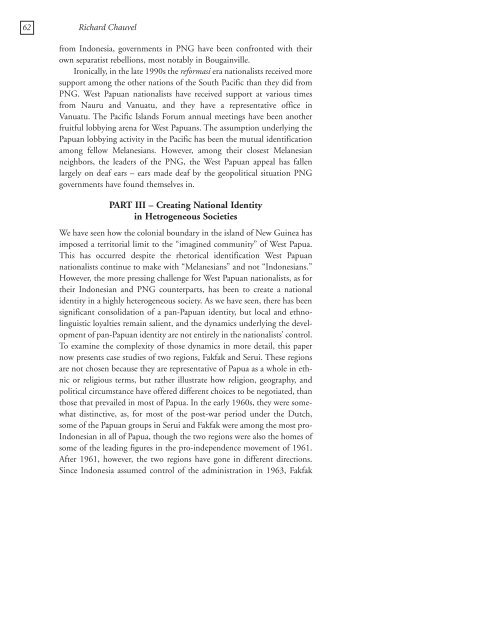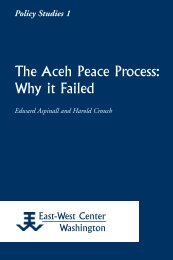Constructing Papuan Nationalism: History, Ethnicity ... - ScholarSpace
Constructing Papuan Nationalism: History, Ethnicity ... - ScholarSpace
Constructing Papuan Nationalism: History, Ethnicity ... - ScholarSpace
- No tags were found...
You also want an ePaper? Increase the reach of your titles
YUMPU automatically turns print PDFs into web optimized ePapers that Google loves.
62 Richard Chauvelfrom Indonesia, governments in PNG have been confronted with theirown separatist rebellions, most notably in Bougainville.Ironically, in the late 1990s the reformasi era nationalists received moresupport among the other nations of the South Pacific than they did fromPNG. West <strong>Papuan</strong> nationalists have received support at various timesfrom Nauru and Vanuatu, and they have a representative office inVanuatu. The Pacific Islands Forum annual meetings have been anotherfruitful lobbying arena for West <strong>Papuan</strong>s. The assumption underlying the<strong>Papuan</strong> lobbying activity in the Pacific has been the mutual identificationamong fellow Melanesians. However, among their closest Melanesianneighbors, the leaders of the PNG, the West <strong>Papuan</strong> appeal has fallenlargely on deaf ears – ears made deaf by the geopolitical situation PNGgovernments have found themselves in.PART III – Creating National Identityin Hetrogeneous SocietiesWe have seen how the colonial boundary in the island of New Guinea hasimposed a territorial limit to the “imagined community” of West Papua.This has occurred despite the rhetorical identification West <strong>Papuan</strong>nationalists continue to make with “Melanesians” and not “Indonesians.”However, the more pressing challenge for West <strong>Papuan</strong> nationalists, as fortheir Indonesian and PNG counterparts, has been to create a nationalidentity in a highly heterogeneous society. As we have seen, there has beensignificant consolidation of a pan-<strong>Papuan</strong> identity, but local and ethnolinguisticloyalties remain salient, and the dynamics underlying the developmentof pan-<strong>Papuan</strong> identity are not entirely in the nationalists’ control.To examine the complexity of those dynamics in more detail, this papernow presents case studies of two regions, Fakfak and Serui. These regionsare not chosen because they are representative of Papua as a whole in ethnicor religious terms, but rather illustrate how religion, geography, andpolitical circumstance have offered different choices to be negotiated, thanthose that prevailed in most of Papua. In the early 1960s, they were somewhatdistinctive, as, for most of the post-war period under the Dutch,some of the <strong>Papuan</strong> groups in Serui and Fakfak were among the most pro-Indonesian in all of Papua, though the two regions were also the homes ofsome of the leading figures in the pro-independence movement of 1961.After 1961, however, the two regions have gone in different directions.Since Indonesia assumed control of the administration in 1963, Fakfak
















